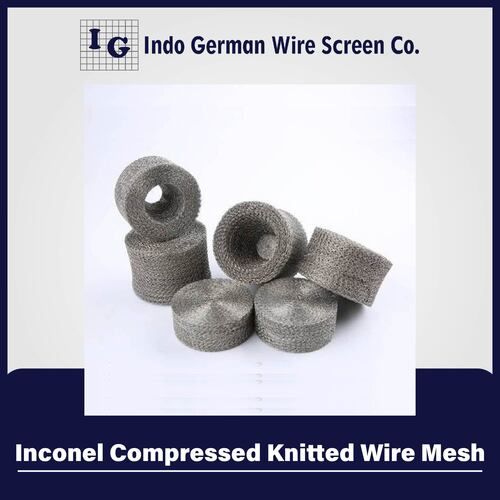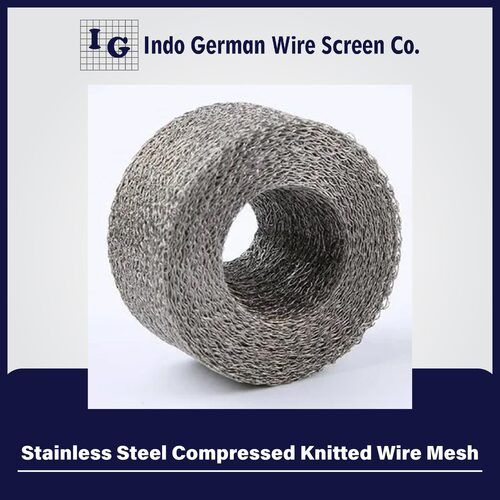Brass Compressed Knitted Wire Mesh
Price 50 INR/ Unit
Brass Compressed Knitted Wire Mesh Specification
- Wire Gauge
- 0.16 mm - 0.30 mm
- Surface Treatment
- Coated
- Length
- Rolls of 10 m, 15 m, or custom length
- Hole Shape
- Round
- Aperture
- 2 mm - 5 mm
- Product Type
- Wire Mesh
- Mesh Type
- Compressed
- Mesh Style
- Knitted Wire Mesh
- Material
- Other
- Alloy
- Brass (CuZn)
- Application
- Other
- Dimensions
- Custom or Standard: 30 mm to 100 mm width
- Wire Diameter
- 0.15 mm - 0.28 mm
- Weight
- 80 g/m to 350 g/m
- Color
- Golden
Brass Compressed Knitted Wire Mesh Trade Information
- Minimum Order Quantity
- 1 Unit
- Supply Ability
- 5000 Units Per Month
- Delivery Time
- 7 Days
About Brass Compressed Knitted Wire Mesh
Brass is an alloy of copper and zinc and has improved resistance to abrasion and corrosion. Compared to copper, Brass has low electrical conductivity and is frequently used in sieving diversified pellets, powder, porcelain clay and glass, chinaware printing, filtering liquid and gas.Brass Compressed Knitted Wire Meshis available in all types of shapes like round, rectangular, disc, ring, trapezoid, column, cylinder, oval, and strip shape.We offer an exclusive range ofBrass Compressed Knitted Wire Meshat unmatched quality and market leading prices.
Superior Filtration and Corrosion Resistance
This brass wire mesh offers up to 98% filtration efficiency, ensuring thorough separation in demanding applications. Its robust brass construction and exceptional corrosion resistance make it suitable for hostile environments, including chemical plants and outdoor installations, while the coated surface enhances longevity and performance.
Customizable Forms and Packaging
Available in a range of shapescylindrical, rectangular, or customand customizable lengths and widths, this mesh can be tailored to exact specifications. Packaging options include rolls or individual custom packages, ensuring convenience in transport, storage, and application.
Wide Application Range
Brass compressed knitted wire mesh is ideal for EMI shielding, demister pads, gas-liquid separation, and vibration absorption. Its sturdy build and efficient filtration ensure consistent, reliable performance across diverse industries.
FAQs of Brass Compressed Knitted Wire Mesh:
Q: How does the brass compressed knitted wire mesh maintain high filtration efficiency?
A: The mesh achieves up to 98% filtration efficiency due to its tightly knitted structure and precisely controlled apertures ranging from 2 mm to 5 mm. This design effectively traps particulates while allowing for optimal gas or liquid flow during separation processes.Q: What are the typical usage scenarios for this product?
A: The mesh is commonly used in EMI shielding, demister pads, gas-liquid separation, and to absorb vibrations in machinery. Its flexible shape and excellent corrosion resistance also make it ideal for automotive, chemical, and electronics industries.Q: When should I consider using a coated brass knitted wire mesh instead of an uncoated version?
A: A coated mesh is preferable when additional protection against moisture, chemicals, or environmental exposure is required. The coating extends the lifespan of the mesh, especially useful in corrosive or harsh conditions.Q: Where can I get the mesh in custom dimensions or packaging?
A: The mesh can be supplied in custom shapes, widths (30 mm to 100 mm), lengths (including 10 m and 15 m rolls), and packaging. You can contact the manufacturer, exporter, supplier, or trader in India to specify your requirements for tailored solutions.Q: What is the process involved in manufacturing the compressed knitted wire mesh?
A: Manufacturing involves knitting high-quality brass wire (diameter 0.15 mm - 0.28 mm) into a flexible mesh, compressing it to the desired density and form, then applying a surface coating to enhance durability and corrosion resistance. Custom shapes are cut and packed as per client specifications.Q: What benefits does brass wire mesh offer compared to other materials?
A: Brass mesh combines excellent corrosion resistance, electrical conductivity, and high tensile strength (280 MPa typical) with a visually appealing golden color. Its durability and versatility make it advantageous over other metals for filtration, screening, and shielding applications.

Price:
- 50
- 100
- 200
- 250
- 500
- 1000+
More Products in Brass Compressed Knitted Wire Mesh Category
Inconel Compressed Knitted Wire Mesh
Price 50 INR / Unit
Minimum Order Quantity : 1 Unit
Mesh Type : Other , Compressed Knitted Mesh
Color : Silver
Mesh Style : Plain Mesh
Surface Treatment : Coated
Monel Compressed Knitted Wire Mesh
Price 50 INR / Unit
Minimum Order Quantity : 1 Unit
Mesh Type : Other , Compressed Knitted Mesh
Color : Silver
Mesh Style : Knitted Wire Mesh
Surface Treatment : Coated
Iron Compressed Knitted Wire Mesh
Price 50 INR / Unit
Minimum Order Quantity : 1 Unit
Mesh Type : Other , Knitted
Color : Silver
Mesh Style : Plain Mesh
Surface Treatment : Coated
Stainless Steel Compressed Knitted Wire Mesh
Price 50 INR / Unit
Minimum Order Quantity : 1 Unit
Mesh Type : Steel Wire Mesh
Color : Silver
Mesh Style : Knitted Wire Mesh
Surface Treatment : Coated
 |
INDO GERMAN WIRE SCREEN CO.
All Rights Reserved.(Terms of Use) Developed and Managed by Infocom Network Private Limited. |
 English
English Spanish
Spanish French
French German
German Italian
Italian Chinese (Simplified)
Chinese (Simplified) Japanese
Japanese Korean
Korean Arabic
Arabic Portuguese
Portuguese
 Send Inquiry
Send Inquiry




